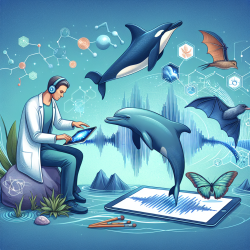Introduction
In the ever-evolving field of special education, understanding the intricacies of sensory processing can provide significant insights into how we support our students. One fascinating area of study is echolocation, a natural phenomenon most commonly associated with bats and dolphins. The research article titled Introduction to special issue, “How nature shaped echolocation in animals” offers a deep dive into how these animals have adapted their sensory systems to navigate and hunt in their environments. This blog explores how the principles of echolocation can be applied to enhance the skills of practitioners working with students who have sensory processing challenges.
The Science of Echolocation
Echolocation is a process by which animals emit sound waves and listen to the echoes that bounce back from objects in their environment. This allows them to determine the location, size, and shape of objects, even in complete darkness. The research article highlights the work of notable scientists such as Elisabeth Kalko and Björn Siemers, who made groundbreaking discoveries in the field of echolocation.
Elisabeth Kalko's research focused on the diversity and richness of bat behaviors, particularly their hunting and echolocation strategies. Her work set new standards for fieldwork on bat echolocation and has been frequently cited in subsequent studies. Similarly, Björn Siemers' research on sensory ecology provided insights into how different species of bats use echolocation to perceive their prey in cluttered environments.
Applying Echolocation Principles in Special Education
While echolocation is specific to certain animal species, the underlying principles can be applied to human sensory processing. Here are some ways practitioners can incorporate these insights into their work:
- Sensory Integration Therapy: Understanding how animals process sensory information can inform sensory integration techniques used with students who have sensory processing disorders.
- Adaptive Technology: Echolocation principles can inspire the development of adaptive technologies that assist students with visual impairments in navigating their environments.
- Environmental Modifications: Creating environments that minimize sensory overload can be informed by how animals adapt their echolocation to different habitats.
Encouraging Further Research
The field of sensory ecology offers vast opportunities for further research. Practitioners are encouraged to explore how the principles of echolocation can be applied to enhance educational strategies for students with sensory processing challenges. By understanding the natural adaptations of animals, we can develop innovative approaches to support our students.
Conclusion
The research on echolocation provides valuable insights into sensory processing that can be applied in special education settings. By incorporating these principles into our practice, we can better support students with sensory processing challenges and enhance their learning experiences. For those interested in delving deeper into this fascinating topic, I highly recommend reading the original research paper.
To read the original research paper, please follow this link: Introduction to special issue, “How nature shaped echolocation in animals”.










